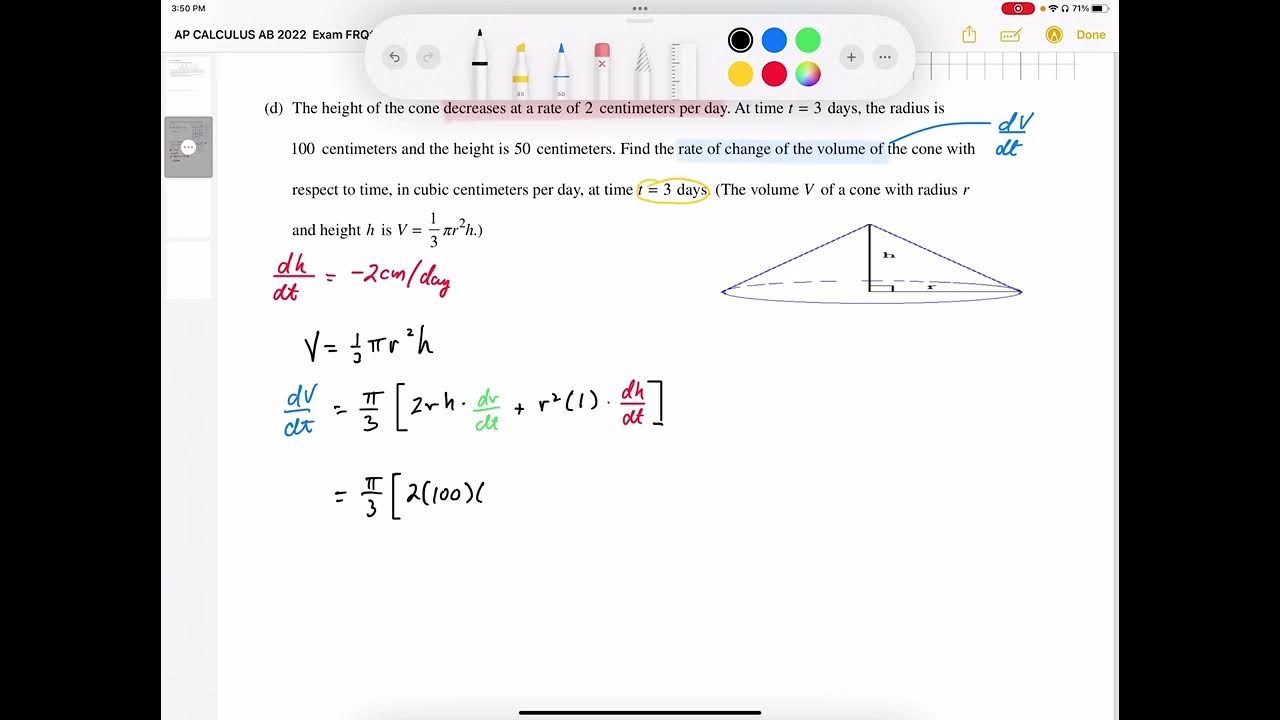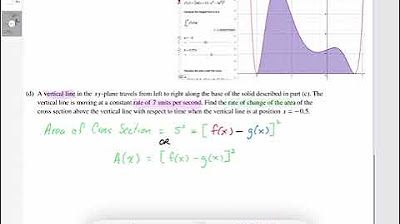Rates-of-change (part 2)
TLDRThe video script explores the concept of rates of change, using the analogy of a ripple in a pond to illustrate how the area enclosed by the ripple changes over time. It explains the relationship between the area of a circle (pi r squared) and the radius, and applies the chain rule to find the rate of change of the area with respect to time. The script also touches on the interesting relationship between the derivative of the area and the circumference of a circle, and hints at further exploration of derivatives and integrals in relation to spheres. The problem is solved by substituting the given radius value into the derived formula, resulting in a final answer of 12 pi square meters per second for the rate of change of the area.
Takeaways
- 🌊 The problem discussed involves a ripple created by dropping a rock into a pond, focusing on a single ripple and its geometric properties.
- 📐 The ripple's radius (r) from the center is denoted as 'r', and it is given that this radius expands at a rate of 2 meters per second.
- 🔄 The area of the circle (A) included by the ripple is related to the radius (r) by the formula A = πr².
- 📈 The goal is to find the rate of change of the area (A) with respect to time (t) when the radius (r) is 3 meters.
- 🔢 The chain rule is applied to find the rate of change of the area with respect to time, which is da/dt = (dA/dr) * (dr/dt).
- 🧮 The derivative of the area with respect to the radius (dA/dr) is calculated to be 2πr, which is also the formula for the circumference of a circle.
- 🔄 The rate of change of the area with respect to time (da/dt) is found by multiplying 2πr by the rate of change of the radius with respect to time (dr/dt), which is 2 meters per second.
- 📌 When r is 3 meters, the rate of change of the area (da/dt) is calculated to be 12π square meters per second.
- 🌐 The script suggests further exploration of the relationships between the area of a circle, the circumference, and the volume and surface area of a sphere.
- 🚀 The video script concludes by emphasizing the broad applicability of rates of change to various problems where relationships between values can be established.
Q & A
What is the main concept discussed in the script?
-The main concept discussed in the script is the rate of change, specifically in the context of a ripple created by dropping a rock into a pond and how the area of the ripple changes over time.
How does the script introduce the problem?
-The script introduces the problem by describing a scenario where a rock is dropped into a pond, creating a ripple that spreads out in a circular pattern, and asks how the area enclosed by the ripple changes with time.
What is the given rate of the ripple spreading out?
-The given rate of the ripple spreading out is 2 meters per second.
What is the relationship between the area of a circle and its radius?
-The relationship between the area of a circle and its radius is given by the formula Area (a) = pi * r^2, where r is the radius.
What is the chain rule as it applies to this problem?
-The chain rule as it applies to this problem states that the rate of change of an area (a) with respect to time (t) is equal to the rate of change of area with respect to radius (r) times the rate of change of radius with respect to time.
What is the derivative of the area with respect to the radius?
-The derivative of the area with respect to the radius is da/dr = 2 * pi * r, which is also the formula for the circumference of a circle.
What is the rate at which the area is changing with respect to time when the radius is 3 meters?
-The rate at which the area is changing with respect to time when the radius is 3 meters is 12 * pi square meters per second.
How does the script suggest the relationship between the derivative of an area and the circumference of a circle?
-The script suggests that the derivative of the area of a circle with respect to its radius is equal to the circumference of the circle, which is a fascinating relationship.
What additional topics are hinted at in the script for further exploration?
-The script hints at further exploration of the volume of a sphere, the surface area of a sphere, and the relationships between derivatives and integrals of these quantities.
What is the significance of the problem discussed in the script?
-The significance of the problem is to demonstrate the application of the rate of change not only in geometric contexts but also in any situation where a relationship between two values can be established.
What is the main takeaway from the script for the viewer?
-The main takeaway for the viewer is understanding how to apply the concept of the rate of change to real-world scenarios, such as the ripple in a pond, and how it can reveal interesting relationships between different quantities.
Outlines
🌊 Ripple Propagation and Area Change
This paragraph introduces a problem involving a ripple created by dropping a rock into a pond. The focus is on understanding the rate of change of the ripple and how it relates to the area it encompasses. The speaker explains that the ripple moves outward at a rate of 2 meters per second and uses the concept of radius (r) to describe the distance from the center of the ripple. The main question posed is to find the rate at which the area enclosed by the ripple changes over time, specifically when the ripple's radius is 3 meters. The speaker then applies the chain rule from calculus to find the rate of change of the area (a) with respect to time (t). The chain rule states that the rate of change of a function (in this case, area) with respect to another variable (time) is equal to the derivative of the function with respect to the intermediate variable (radius) times the rate of change of that intermediate variable with respect to time. The area of a circle is given by the formula A = pi * r^2, and by differentiating both sides with respect to r, the speaker finds that the derivative of the area with respect to radius is 2 * pi * r. This result is intriguing as it reveals that the derivative of the area is equivalent to the circumference of the circle. The speaker then calculates the rate of change of the area by multiplying the derivative of the area with respect to radius (2 * pi * r) by the rate of change of radius with respect to time (2 meters per second). After substituting the given radius value (r = 3 meters), the final rate of change of the area with respect to time is found to be 12 * pi square meters per second.
📈 Final Calculation and Future Applications
In this paragraph, the speaker concludes the problem by performing the final calculation to find the rate of change of the area with respect to time when the radius of the ripple is 3 meters. By substituting r with 3 meters into the previously derived formula, the speaker calculates the rate to be 12 * pi square meters per second. The speaker emphasizes the significance of this result, as it represents the rate at which the area of the circle is changing over time. The speaker also mentions that the next video will tackle a more complex rate of change problem, highlighting that the concepts discussed are not limited to geometric applications but can be applied to any situation where a relationship between two values can be established. The paragraph ends with a teaser for the next module, encouraging viewers to continue exploring the fascinating relationships between derivatives and integrals in various mathematical contexts, such as comparing the area of a circle to the volume and surface area of a sphere.
Mindmap
Keywords
💡rates of change
💡ripple
💡distance
💡area
💡chain rule
💡derivative
💡antiderivative
💡geometry
💡circle
💡radius
💡circumference
Highlights
The problem focuses on the rate of change of a ripple created by dropping a rock into a pond, which is a practical application of calculus in understanding geometrical phenomena.
The ripple is assumed to spread out at a constant speed of 2 meters per second, providing a basis for calculating the rate of change.
The distance of the ripple from the center (r) is used to represent the radius of the circle formed by the ripple, which is key to understanding the area calculation.
The area (A) of the circle is related to the radius (r) by the formula A = pi * r^2, which is essential for finding the rate of change of the area with respect to time.
The chain rule is introduced as a fundamental concept in calculus to find the rate of change of an area with respect to time, based on the rate of change of radius.
The derivative of the area with respect to the radius (r) is found to be 2 * pi * r, which is interestingly the formula for the circumference of a circle.
The antiderivative of the area in relation to the volume and surface area of a sphere is suggested as an intriguing topic for further exploration.
The rate of change of the area with respect to time is calculated by multiplying the derivative of the area with respect to the radius by the rate of change of the radius with respect to time.
When the radius is 3 meters, the rate of change of the area with respect to time is calculated to be 12 * pi square meters per second.
The problem demonstrates the application of calculus in real-world scenarios beyond purely geometrical problems, showing its versatility.
The video content encourages viewers to understand that calculus can be applied to find relationships between different values in various contexts.
The next video promises a more complex rate of change problem, indicating a progressive approach to teaching calculus.
The transcript serves as an educational resource for learning how to apply calculus to solve problems involving rates of change in geometrical shapes.
The content is engaging and informative, providing a clear explanation of the concepts and calculations involved in finding rates of change.
The problem-solving process is well-structured, guiding the learner step by step through the application of calculus to the given scenario.
The transcript highlights the importance of understanding the fundamental concepts of calculus, such as the chain rule and derivatives, for solving more complex problems.
The discussion of the derivative and antiderivative of the area in relation to other geometrical properties of a sphere opens up possibilities for interdisciplinary learning.
Transcripts
Browse More Related Video

Related rates intro | Applications of derivatives | AP Calculus AB | Khan Academy

How to solve a changing area of circle with related rates

How to find the radius when the area and circumference are changing at the same rate

AP CALCULUS AB 2022 Exam Full Solution FRQ#4d

AP CALCULUS AB 2022 Exam Full Solution FRQ#2d

Math Antics - Circles, Circumference And Area
5.0 / 5 (0 votes)
Thanks for rating: